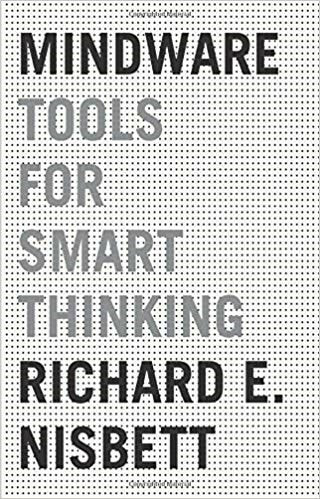ISBN-10: 0374112673
ISBN-13: 978-0374112677
APA Style Citation
Nisbett, R. E. (2015). Mindware: Tools for smart thinking. New York, NY: Farrar, Straus and Giroux.
Buy This Book
https://www.amazon.com/Mindware-Tools-Thinking-Richard-Nisbett/dp/0374112673/ref=tmm_hrd_swatch_0?_encoding=UTF8&qid=&sr=&dpID=61YCTcmKbhL&preST=_SY291_BO1,204,203,200_QL40_&dpSrc=detail
| mindware_activity.pdf |
| mindware_examples_activity.pdf |
Will what you learn in college affect how you think about everyday life? Yes. The book Mindware: Tools for Smart Thinking addresses how scientific and philosophical thought can be taught to affect reasoning in everyday life. The key is how events are framed and coded. The concepts in the book are important, teachable, and central.
There are six main parts to the book. The first part is about thinking about the world. It explains how we think, the mistakes we make, how to fix those mistakes, and how to improve our thinking. In order to make fewer errors in judgment, we should be careful of inferences, be aware of schemas, recognize how incidental and irrelevant perceptions can affect our thinking, and recognize the power of heuristics. In order to improve our thinking, we should pay more attention to context, recognize the power of the situation for ourselves as well as others, and know that people can change. In daily life we should not assume that we know why we think the way we do.
The second part is about choices. It focuses on economics and real-life examples for the reader. The third part is about making categorizations of the world. It explains attributions and more specifically the fundamental attribution error. The fourth part is about causality. The focus is on experiments. The fifth part is about types of reasoning. The abstract and formal deductive reasoning are associated with Western thinking. While the dialectical reasoning is associated with Eastern thinking. The sixth part is about what makes a good theory. For example, the principle KISS- Keep It Simple, Stupid- provides the basis for a good theory. The principles of reductionism, hypothesis testing, confirmation bias, and falsifiability are also addressed. Overall, this book points out how our beliefs can often be wrong, but we can also be more aware and compensate for this. The tools offered by Nisbett, with a little practice, can enhance your smart thinking.
Other Related Resources
Author website
http://www-personal.umich.edu/~nisbett/
The Psychology of Thinking Video
https://www.youtube.com/watch?v=XKm4VoExc0Q
Q and A
https://www.youtube.com/watch?v=V2Ci4ro75fM
The Guardian Article
https://www.theguardian.com/science/2015/aug/09/world-in-context-mindware-tools-for-sharp-thinking
Psychological Figures and Concepts
Alfred Binet
Aristotle
B.F. Skinner
Charles Darwin
Edward Thorndike
Ivan Pavlov
Jean Piaget
John Darley and Bibb Latané
Martin Seligman
Norman Triplett
Plato
Robert Zajonc
Rorschach
Sigmund Freud
William James
Actor-observer bias
Animal models
Availability heuristic
Bystander intervention
Chi square
Cocktail party phenomenon
Cognitive dissonance theory
Concrete operations
Confirmation bias
Conformity
Conservation
Context-dependent
Correlation
Cost-benefit analysis
Culture
Death instinct
Deductive reasoning
Dialectical reasoning
Dispersion
Dispositional attribution
Double-blind
Evolutionary theory
Extrasensory perception
Formal operation
Framing
Fundamental attribution error
Halo effect
Heuristics
Hypothesis
Illusory correlations
Implicit Association Test
Inductive reasoning
Inference
Insight
Interview illusion
Introspection
IQ tests
Law of large numbers
Learning
Mental illness
Mere exposure
Modeling
Multiple regression analysis (MRA)
Natural experiments
Normal distribution
Oedipus complex
Overjustification effect
Pearson correlation coefficient
Percentile rank
Phobia
Population
Postformal operations
Problem-solving
Pseudoscience
Psychoanalytic theory
Psychosexual stages
Random assignment
Range
Reference group effect
Regression
Regression to the mean
Reinforcement learning theory
Reliability
Representative heuristic
Sample
Sample bias
Scatterplots
Schemas
Scientific method
Self-enhancement bias
Self-selection
Set point
Situational attribution
Social desirability bias
Social facilitation effect
Social influence
Social psychology
Spreading activation
Standard deviation
Statistically significant
Statistics
Stereotypes
Subliminal perception and persuasion
Surveys
Syllogisms
Theory
Tragedy of the commons
Transference
Trauma
Unconscious mind
Validity
Ventromedial hypothesis
Vicarious reinforcement theory
Within design

 RSS Feed
RSS Feed